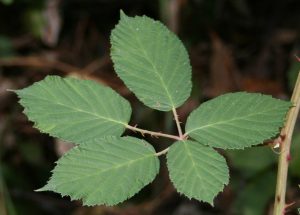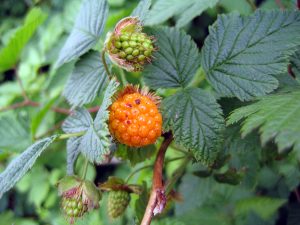
Himalayan Blackberry (Rubus armeniacus) fruits.
Image by Johnida Dockens, licensed under CC BY-NC-ND 2.0
If you are someone with a deep love of the natural world like me or even someone who is just curious about the happenings in your backyard, then this post is for you! Without further ado, allow me to introduce my little argument against blackberry bushes!
If you have ever walked through Pacific Spirit Regional Park during August you will see the paths framed by hundreds of blackberry bushes with a conspicuous lack of fruit at arm’s height. In my daily runs through the park I have watched as individuals and families bring baskets and fill them with the spoils or simply eat them right off the branch. I am guilty of this myself. Just last summer I spent an hour walking about picking blackberries and was stupid enough to try to use my shirt to collect them which stained it purple. Later though, I baked a delicious blackberry pie so I think it was worth it in the end.
So overall, what’s not to like about blackberries? Well, for starters the majority of blackberries found in Pacific Spirit Regional Park are called Himalayan Blackberries (Rubus armeniacus) and are actually an invasive species. This means that they do not originate in Vancouver. They were introduced by humans and are now taking over and thriving in our forests. Second, blackberry thorns are the bane of my existence.
But back to the important point against these blackberries, the fact that they are an invasive species. I did not actually find out about their invasive status until I began volunteering with Pacific Spirit Park Society last year. Now I should note that there are native blackberries in the park called Trailing Blackberries (Rubus ursinus), but those are oftentimes outcompeted by the Himalayan Blackberry, so the majority seen in the park are their invasive cousins.
Originating in Armenia, the Himalayan Blackberry was purposefully introduced in North America in the 19th century because of their fruit production. However, they soon grew out of control and they now cover vast areas of forest undergrowth in multiple Vancouver forests. Some regions of the park are made up of almost 100% Himalayan Blackberry.
At this point, you might be wondering at this point why should you care? Ecologically, these plants are incredibly damaging. They reproduce and grow extremely quickly, making them strong competitors in the forest ecosystem. Given this quick growth, the leaves create an abundance of shade, which can kill native shade-intolerant plants such as the Ponderosa Pine and other slow growing native conifers, thus could change the makeup of the forest from primarily evergreen to primarily deciduous. This disrupts the natural ecosystem and kills off native plants and forms dense thorny thickets impassable by large animals.
The quick growing dense and thorny thickets could also present difficulties to forest management and recreation. They easily intrude on forest trails, resulting in the need for consistent maintenance because no one wants to be running on a forest trail and get snagged by an encroaching blackberry thorn. Even if you are not a regular in the woods, these invasive blackberries can easily creep into your garden and quickly take over. They produce thick roots that burrow deep in the ground, making their removal extremely difficult. Some roots have been recorded to dip 90 cm into the ground and span 10 m in total! Not to mention the large thorns that can easily cut your hands if you attempt to manually remove them. Don’t want that in your garden? Then you might be interested in supporting efforts to remove these invasive plants.
Starting in 2014, Metro Vancouver in partnership with Pacific Spirit Park Society attempted to restore and are continually monitoring six sites in Pacific Spirit Regional Park by removing the invasive plants and planting native ones in their stead. Over the past year, I have been involved in both the monitoring program with Pacific Spirit Park Society as well as data analysis on the progress of their restoration efforts. I have spent hours working on monitoring in the park and bear many battle scars and a hole in my rain jacket from blackberry thorns. Needless to say, I highly recommend against trying to walk through Himalayan Blackberry thickets.
Though they have been making tremendous progress with their attempts to curb the domination of the Himalayan Blackberry, the problem is far-reaching. Even after the restoration, some sites that I have monitored remain largely blackberry. These efforts need to be done on a much larger scale, meaning that more restoration and invasive removal projects like that being conducted in Pacific Spirit Regional Park are needed to fully tackle the invasive blackberry problem.
This includes a concrete monitoring plan to regularly check back on the progress of the restoration. Restoration does not always mean that, once initially completed, the ecosystem will be entirely self-sufficient and there is no need of further interference. Given the complexity of ecosystems, human-designed restoration does not always work on the first try and is oftentimes an ongoing process. Without continual monitoring, there is no way of knowing if the attempted restoration actually succeeded or if anything went wrong.
At this point you might be wondering what you can do to help limit the spread of the invasive blackberry. The best way is to join volunteer groups working to remove them and also learn how to identify them, so if they appear in your garden you can remove them. But make sure to wear thick gloves because the thorns are quite painful. The Himalayan Blackberry usually grows in large bushes with thick stems, has large thorns, and has three to five large round leaflets (Above). The native Trailing Blackberry on the other hand grows close to the ground and has narrow stems with smaller thorns and only three oval leaflets (Below).

Five leaflets of a Himalayan Blackberry (Rubus armeniacus).
Image by born1954, licensed under CC BY 2.0

Three leaflets of a Trailing Blackberry (Rubus ursinus)
Image by George Wesley & Bonita Dannells, licensed under CC BY-NC-ND 2.0
If the issue of a lack of edible berries crossed your mind at any point during this post, don’t worry! The native blackberry produces edible fruits as well that are sweeter than the Himalayan, so you will still have plenty of blackberries to pick. Also another native shrub, the Salmonberry (Rubus spectabilis) shown below, produces orange-to-red coloured edible fruit from May to July, which I personally think are superior to blackberries in appearance and taste.

Salmonberry fruit (Rubus spectabilis)
Image by Ruth Hartnup, licensed under CC BY 2.0
I hope this served as some food for thought!

 Follow
Follow